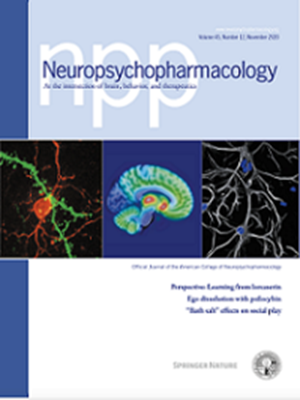Endocannabinoid contributions to the perception of socially relevant, affective touch in humans
IF 6.6
1区 医学
Q1 NEUROSCIENCES
引用次数: 0
Abstract
Social relationships are central to well-being. A subgroup of afferent nerve fibers, C-tactile (CT) afferents, are primed to respond to affective, socially relevant touch and may mitigate the effects of stress. The endocannabinoid ligand anandamide (AEA) modulates both social reward and stress. We thus hypothesized that AEA levels would be associated with the perceived pleasantness of affective touch in humans. Across two studies, we explored perceptions of affective, socially relevant touch and general affective stimuli. In study 1, adult participants (N = 101) were recruited based on presence (CM+) or absence (CM−) of documented childhood maltreatment (N = 52 CM+; N = 49 CM−). In study 2, healthy individuals were randomized to receive an inhibitor of fatty acid amide hydrolase (FAAH; PF-04457845) to increase AEA levels (n = 16) or placebo (n = 29). Outcomes included self-report ratings of touch pleasantness and intensity, valence and arousal ratings of affective images, and plasma levels of endocannabinoids AEA and 2-AG, cortisol, and oxytocin. In study 1, higher AEA levels were associated with a reduced preference for affective, CT-optimal touch. In study 2, pharmacological elevation of AEA resulted in reduced preference for affective touch. These effects were specific to social processing, as AEA levels were not related to ratings of affective images. In contrast to our hypothesis, elevated AEA was associated with reduced pleasantness ratings of CT-optimal, affective touch. This provides novel, in-human data linking AEA to social processing, adding nuance to the rationale for its use as a potential novel therapeutic target in disordered in social processing.

内源性大麻素有助于人类感知社会相关的情感触摸。
社会关系是幸福的核心。传入神经纤维的一个亚群,c -触觉传入神经(CT),对情感,社会相关的触摸作出反应,并可能减轻压力的影响。内源性大麻素配体anandamide (AEA)调节社会奖励和压力。因此,我们假设AEA水平与人类感知到的情感触摸的愉悦度有关。在两项研究中,我们探索了情感、社会相关触摸和一般情感刺激的感知。在研究1中,成年参与者(N = 101)根据存在(CM+)或不存在(CM-)记录的儿童虐待(N = 52 CM+;N = 49 cm -)。在研究2中,健康个体随机接受脂肪酸酰胺水解酶(FAAH)抑制剂;PF-04457845)增加AEA水平(n = 16)或安慰剂(n = 29)。结果包括自我报告的触摸愉悦度和强度评分、情感图像的效价和唤醒评分、血浆内源性大麻素AEA和2-AG、皮质醇和催产素水平。在研究1中,较高的AEA水平与对情感、ct优化触摸的偏好降低有关。在研究2中,药理学上AEA的升高导致对情感触摸的偏好降低。这些影响是特定于社会处理的,因为AEA水平与情感图像的评级无关。与我们的假设相反,高AEA与降低的ct最佳情感触摸的愉悦度评级有关。这提供了将AEA与社会处理联系起来的新颖的人体数据,为其作为社会处理障碍的潜在新治疗靶点的基本原理增加了细微差别。
本文章由计算机程序翻译,如有差异,请以英文原文为准。
求助全文
约1分钟内获得全文
求助全文
来源期刊

Neuropsychopharmacology
医学-精神病学
CiteScore
15.00
自引率
2.60%
发文量
240
审稿时长
2 months
期刊介绍:
Neuropsychopharmacology is a reputable international scientific journal that serves as the official publication of the American College of Neuropsychopharmacology (ACNP). The journal's primary focus is on research that enhances our knowledge of the brain and behavior, with a particular emphasis on the molecular, cellular, physiological, and psychological aspects of substances that affect the central nervous system (CNS). It also aims to identify new molecular targets for the development of future drugs.
The journal prioritizes original research reports, but it also welcomes mini-reviews and perspectives, which are often solicited by the editorial office. These types of articles provide valuable insights and syntheses of current research trends and future directions in the field of neuroscience and pharmacology.
 求助内容:
求助内容: 应助结果提醒方式:
应助结果提醒方式:


